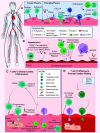Red light-green light: T-cell trafficking in cardiac and vascular inflammation
- PMID: 36409175
- PMCID: PMC9762958
- DOI: 10.1152/ajpcell.00421.2022
Red light-green light: T-cell trafficking in cardiac and vascular inflammation
Abstract
Extravasation of T cells from the bloodstream into inflamed tissues requires interactions between T cells and vascular endothelial cells, a necessary step that allows T cells to exert their effector function during the immune response to pathogens and to sterile insults. This cellular cross talk involves adhesion molecules on both the vascular endothelium and the T cells themselves that function as receptor-ligand pairs to slow down circulating T cells. These will eventually extravasate into sites of inflammation when they receive the correct chemokine signals. Accumulation of T cells within the vascular wall can lead to vessel thickening and vascular disease, whereas T-cell extravasation into the myocardium often leads to cardiac chronic inflammation and adverse cardiac remodeling, hallmarks of heart failure. On the flip side, T-cell trafficking is required for pathogen clearance and to promote tissue repair after injury resulting from cardiac ischemia. Thus, a better understanding of the central players mediating these interactions may help develop novel therapeutics to modulate vascular and cardiac inflammation. Here, we review the most recent literature on pathways that regulate T-cell transendothelial migration, the last step leading to T-cell infiltration into tissues and organs in the context of vascular and cardiac inflammation. We discuss new potential avenues to therapeutically modulate these pathways to enhance or prevent immune cell infiltration in cardiovascular disease.
Keywords: cardiovascular; inflammation; leukocytes; pathophysiology; trafficking.
Conflict of interest statement
No conflicts of interest, financial or otherwise, are declared by the authors.
Figures


References
Publication types
MeSH terms
Grants and funding
LinkOut - more resources
Full Text Sources

